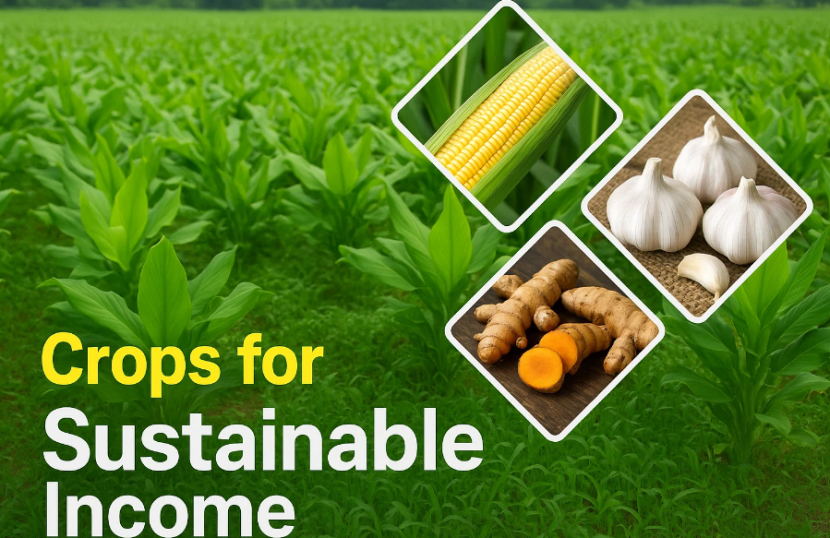In today’s agriculture, striking a balance between profitability and sustainability is crucial. With growing climate challenges, rising input costs, and shifting consumer preferences, modern farmers are choosing crops that are eco-friendly, market-ready, and profitable.
If you’re looking to build long-term income while supporting soil health and environmental balance, here are the top 10 Profitable Crops you should consider.
1. Turmeric (Haldi)

Turmeric is prized for its medicinal, culinary, and cosmetic uses. It thrives in warm climates and has a strong global demand for exports.
Why it’s smart: High ROI, minimal maintenance, and excellent shelf life.
🔗 Explore market trends for turmeric at Spices Board India
2. Pulses (Moong, Arhar, Lentils)

Pulses improve soil health by fixing nitrogen naturally. They’re water-efficient and crucial for India’s food security.
Why it’s smart: Boosts soil fertility, in demand both domestically and globally.
🔗 Learn about government support at the National Food Security Mission
3. Moringa (Drumstick)

Moringa is called the “miracle tree” due to its rich nutrients and medicinal value. Its leaves and pods are in demand in both the food and pharmaceutical industries.
Why it’s smart: Highly drought-resistant, multipurpose crop.
🔗 Check Moringa’s global health benefits at NIH – National Institutes of Health
4. Aloe Vera

Used in Ayurveda, cosmetics, and beverages, aloe vera requires very little water and grows well in poor soil.
Why it’s smart: Low input cost and high commercial value.
🔗 Explore the aloe vera market growth at Research and Markets
5. Sweet Corn

Popular in fresh, frozen, and processed forms, sweet corn matures quickly and sells well in urban and semi-urban markets.
Why it’s smart: Fast-growing and ideal for short-term profits.
🔗 View demand trends at Agriwatch
6. Sunflower

A low-maintenance oilseed crop with increasing demand in edible oils and livestock feed. It’s climate-resilient and grows well in poor soils.
Why it’s smart: High yield, less water requirement, and good returns.
🔗 Check sunflower oil market trends at Statista
7. Garlic

Garlic enjoys year-round demand in kitchens, medicine, and seasoning products. It stores well and offers good export value.
Why it’s smart: High profit margin and long shelf life.
🔗 Explore garlic health benefits at Healthline
8. Banana

Bananas provide a high annual income through consistent production. They’re versatile for fresh consumption and food processing.
Why it’s smart: Year-round demand and good market price.
🔗 See India’s banana cultivation data at APEDA
9. Groundnut (Peanut)

A short-duration crop that supports soil health and sells in the snack, oil, and feed sectors.
Why it’s smart: Quick returns and multiple uses.
🔗 Review peanut export stats at the Indian Oilseeds and Produce Export Promotion Council (IOPEPC)
10. Millets (Ragi, Bajra, Jowar)

Millets are climate-smart superfoods promoted by the Indian government and international health agencies.
Why it’s smart: Resilient, eco-friendly, and in rising demand for health-conscious consumers.
🔗 Read more about millet promotion at FAO – International Year of Millets 2023
Why These Crops Are Smart Choices
| FACTOR | HOW THESE CROPS WIN |
| Water Efficiency | Millets, aloe vera, pulses—drought resilient |
| Soil Health | Pulses add nitrogen; millets deepen organic matter |
| Short Crop Cycles | Pulses, sweet corn, millets—crop and income rotation |
| High Market Demand | Turmeric, garlic, banana, pulses—strong local & export markets |
| Health & Nutrition | Millets, moringa—added value for health-conscious consumers |
Real-World Impact & Government Support
India is advancing sustainable agriculture through impactful initiatives and global advocacy. In Gumla, Jharkhand, over 30,000 hectares have been revitalized with high-yield pulse seeds, improving both farmer income and soil health. Meanwhile, millets are being reintroduced into public food schemes to combat malnutrition, a key theme at the 2025 Millets Summit in Hyderabad. Their inclusion in the G20 Summit’s cuisine further boosted international awareness and market demand for these climate-resilient grains. For more information, you can also check: What are government subsidies for farmers in India?
Final Thoughts
Choosing eco-smart crops is key to building resilient farms and secure incomes. Pulses and millets form the backbone of sustainable agriculture, enhancing soil fertility, reducing water dependency, and meeting nutritional needs. Meanwhile, value-added crops like turmeric, garlic, aloe, and moringa offer strong profits and market adaptability.
By planting a diversified mix of these sustainable crops, farmers can safeguard their livelihoods, support the environment, and tap into both local and global markets.




